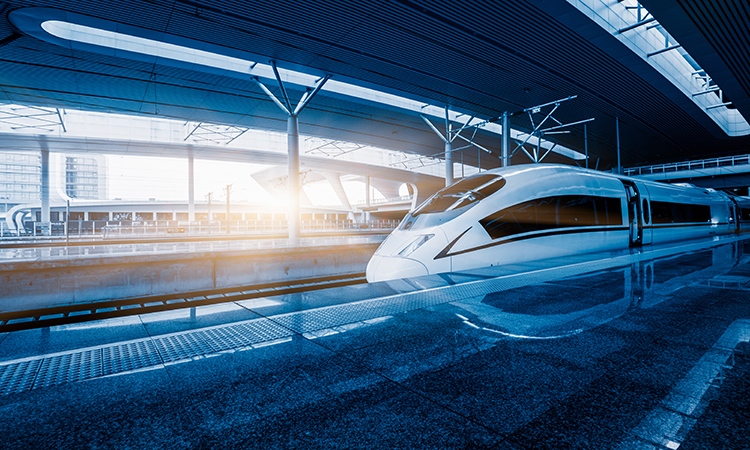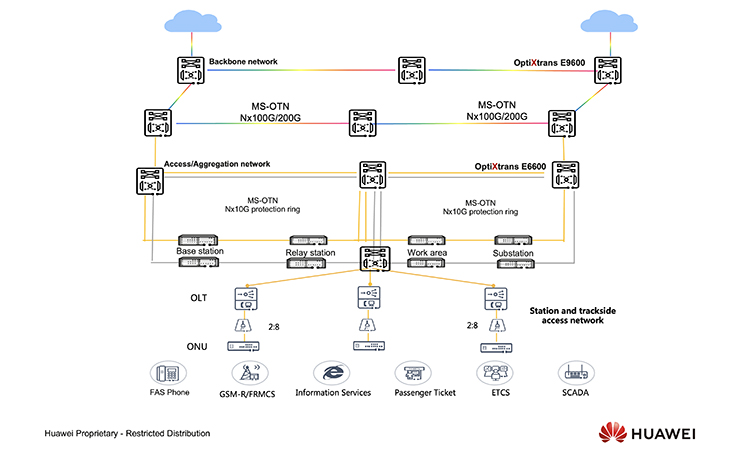Revolutionising high-speed rail with next-generation optical network technology
- Like
- Digg
- Del
- Tumblr
- VKontakte
- Buffer
- Love This
- Odnoklassniki
- Meneame
- Blogger
- Amazon
- Yahoo Mail
- Gmail
- AOL
- Newsvine
- HackerNews
- Evernote
- MySpace
- Mail.ru
- Viadeo
- Line
- Comments
- Yummly
- SMS
- Viber
- Telegram
- Subscribe
- Skype
- Facebook Messenger
- Kakao
- LiveJournal
- Yammer
- Edgar
- Fintel
- Mix
- Instapaper
- Copy Link
Posted: 20 June 2023 | Wan Xifeng - Huawei | No comments yet
For Intelligent Transport, Wan Xifeng, Chief Architect of Huawei’s Enterprise Optical Domain, discusses how the rail industry is being impacted by increased digital transformation, and shares exclusive insight into the company’s future-oriented smart railway solution, which supports improved security, reliability and stability.


What are the current trends in the global railway industry’s digital transformation, and how are they affecting the industry’s development?
The global railway industry is at a critical juncture of digital transformation. In particular, Mobility-as-a-Service (MaaS), green and low carbon, and intelligence are new trends of industry development that will drive more investment in digital transformation.
By building network connections based on 5G and Internet of Things (IoT) technologies and a unified platform based on artificial intelligence (AI), big data and cloud, the railway industry can improve transportation efficiency and security. However, it is important – even necessary – that these new technologies are integrated with service scenarios.
How do you see the need for more advanced railway technologies and innovations supporting the booming high-speed railway industry?
For future high-speed rail, perhaps the first things that we think about are higher speeds, faster departure times and high-speed rail infrastructure built in multiple regions and places, so that we can easily reach where we want to go. In this case, we need to improve the dispatching system and combine track circuits with wireless communication, or even move towards a pure mobile block scheme. The current speed for high-speed rail has reached 350km/h, and the next step will be further increasing this to 400km/h or even higher. Departure time has been reduced to three minutes in some places and, in terms of mileage, the global mileage has exceeded 70,000km.
We can also further analyse the necessity of applying new technologies based on the industry trends mentioned above.
Green and low carbon
Railway transportation mainly adopts electrified traction. So, especially when compared with highway and air transportation, it inherently has the necessary green industry characteristics. However, the application of new technologies such as IoT in the industry can help to reduce the energy consumption of stations, trains and locomotives, making railway transportation greener and low carbon.
Intelligence
To make railway transportation smarter – and to improve transportation efficiency and reduce costs – we need to collect more application data and build a unified platform. Therefore, building a unified platform based on big data and AI becomes the main technological choice. Cloud technologies are used to make the platform more flexible, resilient and DR-capable. As more data needs to be collected and sent to a unified platform, smart networking inevitably poses higher requirements on network connections, which will stimulate the development of 5G, IP and OTN technologies.
Mobility-as-a-Service
The very nature of MaaS requires integration with other transportation modes. A unified platform and 5G-based connection positioning technologies will make MaaS applications more efficient.
Can you explain Huawei’s solution in building a future-oriented smart railway network foundation, as well as how it ensures security, reliability and stability across railway services?
Trains are running faster and more frequently than ever before. A variety of modern railway services need higher bandwidth. Meanwhile, assuring safety and smooth dispatching requires a low latency coupled with high reliability. Plus, legacy interfaces must be integrated with the new infrastructure while physically isolating various service systems.
Our future-oriented smart railway solution focuses on digital platforms and network connections. We have designed an all-optical network uniquely tailored to the needs of smart railways. It ensures security, reliability and stability across railway services.


Credit: Huawei
Our single network can carry a multitude of services — such as PCM, SDH, OTN, and Ethernet — which centrally access the MS-OTN platform. Then, the services are isolated using different cross-connect planes, ensuring their protection. Also, our MS-OTN supports large-capacity transmission by expanding wavelength-level hard pipes, delivering a stable and low latency.
The rapid development of railways accelerates the transformation from lines to multi-line networks, and cloud-based smart services and bandwidth operations drive backbone network construction. A backbone network enables all lines to be interconnected, and backbone OTN takes advantages of high bandwidth and one-hop connection. Finally, backbone OTN resources can be used to achieve bandwidth operation.
Future Railway Mobile Communication System (FRMCS), IP and OTN networks and a unified digital platform are used as bearer networks for important railway applications, such as signalling and Supervisory Control and Data Acquisition (SCADA). These applications further ensure the security and efficiency of railway transportation.
How does the MS-OTN solution, with Optical Service Unit (OSU), reduce investment in secondary network construction in the railway industry?
With the acceleration of high-speed railways and the development of digitalisation and intelligence, there are higher requirements for bandwidth, security, reliability and latency, and the MS-OTN solution with Optical Service Unit (OSU) – which is the evolution of SDH and inherited SDH features – supports multi-service access, huge bandwidth, high security, high reliability and easy E2E O&M. Above all, it supports FRMCS-oriented next-generation bearer network, ensures secure railway operation and reduces investment in secondary network construction in railway industry.
Backbone layer
100G+ per wavelength is used to support Terabit-level expansion, and the capacity can reach 8T+. With the network topology and devices unchanged, continuous capacity expansion can be used to meet the increasing traffic volume caused by the development of smart and cloud services or bandwidth operation. Avoid repeated network construction and save investment.
Aggregation and integrated bearer layer
MS-OTN inherits all features of SDH and has the capabilities of MPLS-TP and OTN/OSU. MS-OTN supports the unified bearer of Global System for Mobile Communications – Railway (GSM-R) and FRMCS. When customers evolvefrom GSM-R to FRMCS, only a few boards need to be added to the bearer network to meet service requirements. In addition, OSU is a new-generation OTN small-granularity timeslot technology. It features flexible granularity, flexible scheduling, lossless bandwidth and hard isolation. One network supports the integrated access of multiple services in the present and future, and is compatible with future service development.
How does Huawei’s all-optical network architecture differ from traditional railway networks, and what are some of the key advantages it provides in terms of supporting smart railway operations and enhancing overall service quality?
On a traditional railway network, the backbone layer uses 10G DWDM technology, the convergence and integrated bearer layer uses the SDH standard, and the multi-layer networking architecture of switches for sections and stations.
However, Huawei’s all-optical network architecture upgrades the backbone layer to 100G+DWDM technology, the convergence and integrated bearer layer uses MS-OTN, and the FTTM all-optical industrial PON layer 2 architecture solution is used for the section and station.
In addition, the following advantages are provided in improving smart operations and overall service quality:
- Ultra-high bandwidth: The single-wavelength rate ranges from 10 Gbit/s to 800 Gbit/s, and the single-fiber capacity reaches 96 Tbit/s, which is 42% higher than the industry standard. Ultra-high-bandwidth backbone networks not only support the rapid increase of communication traffic brought by smart railway operations, but also provide sufficient bandwidth operations, which is a new service growth point
- Flexible access to the cloud: The OSU technology is used to enable one-hop direct service transmission from the end to the control centre, which has the advantage of extremely low latency and supports diversified intelligent railway service applications
- Secure and reliable: Based on SDH, ODUk, and DWDM hard pipe technologies, the MS-OTN platform and all-optical industrial PON supports wavelength isolation and timeslot isolation, implementing E2E isolation and carrying railway services such asETCS, CTC and video services in an E2E manner, ensuring secure railway operation
- Smooth evolution: The MS-OTN platform supports GSM-R services on the SDH plane and FRMCS services on the MPLS-TP plane, ensuring smooth service evolution and protecting customers’ investment
- Simplified O&M: Compared with traditional networks, all-optical networks have great technical advantages while at the same time maintaining the same O&M habits ofMSTP. In addition, all-optical networks support unified device platforms at the backbone layer and bearer layer, greatly reducing OPEX. The next-generation iMaster NCE-based intelligent O&M method enables visualized network resources, visualized link status, and smart fault prediction, which further simplifies network O&M. The single-fiber bidirectional IEEE 1588V2 technology is supported to reduce construction costs.
What are some of the key challenges that railway operators face in implementing advanced technologies, such as Huawei’s all-optical network solution, and how can these challenges be overcome?
Huawei’s all-optical integrated bearer network consists of three layers: backbone transmission layer, aggregation integrated bearer layer and section/station FTTM section/station access layer. The implementation challenges vary depending on the layer in question.
Backbone layer
If a customer builds an OTN DWDM network without a backbone network, the customer will face the challenges of wavelength planning and optical-layer link commissioning. Huawei’s OTN equipment supports automatic optical-layer commissioning, optical link quality visualisation and fault prediction. This greatly reduces the difficulty of optical-layer link commissioning and provides technical support for customers in the network planning phase.
Aggregation and integrated bearer layer
Currently, the SDH network is used on the live network. When the network evolves to the MS-OTN integrated bearer network, the network management system remains unchanged and the SDH O&M and network deployment habits are retained. The conversion cost is extremely low for customers.
Inter-station/station access layer
From the use of switches to the use of fibre to the machine (FTTM) all-optical industrial PON solution, the traditional multi-layer active architecture is replaced by the passive two-layer architecture which is simpler and greener. The all-optical industrial PON solution is also in face of the challenge of passive optical power splitting deployment, but Huawei provides automation tools to respond to the challenges. With this solution, the annual shipment among carriers has exceeded 100 million. The industry ecosystem is very mature.
How significant a role does collaboration with industry stakeholders play in accelerating the deployment and adoption of such technologies, and what benefits can be expected from doing so?
Huawei has cooperated with many design institutes, consulting firms and partners around the world on all-optical integrated bearer networks. Design institutes and consulting firms provide solution planning and consulting suggestions for customers, and partners provide deployment and operation services for customers. We will accelerate the promotion and use of Huawei’s competitive all-optical integrated bearer network solution in the industry, shorten the transition period from the SDH solution to the all-optical integrated bearer network, and enjoy the dividends of advanced technologies.
How do you think advanced technologies – such as artificial intelligence, machine learning and big data – will contribute to the future of the railway industry?
The deployment of advanced technologies such as artificial intelligence, machine learning and big data is based on massive data. With the data, algorithms can be defined or learned based on business scenarios to reduce labour costs and improve productivity.
The data is not only from vehicles, locomotives and stations, but also from the trackside infrastructure, such as bridges and tunnels. Compared with traditional railway production and management methods, a network with more flexible access, larger bandwidth, more secure and more convenient capacity expansion is required to transmit and carry the data. The architecture based on IP over DWDM is a better choice, in which the optical network is the foundation.
Looking to the future, what potential developments and advancements in the global railway industry do you hope to see?
In the actual digital transformation of railway customers, we can see that both the European Union (EU) and China are using the IP over DWDM network architecture to build ICT infrastructure. Huawei’s all-optical network ensures the security and reliability of railway infrastructure and supports the digital transformation of the industry.
For more information about Huawei’s Intelligent Railway All-Optical Connection Solution, visit https://e.huawei.com/en/industries/railway/all-optical-network.


Related topics
5G & Transport Communications, Artificial Intelligence, Cyber-Security, Intelligent Transport Systems (ITS), IoT (Internet of Things), Public Transport, Security & Crime, Sustainable Urban Transport
Related modes
Rail
Related organisations
Huawei
Related people
Wan Xifeng








